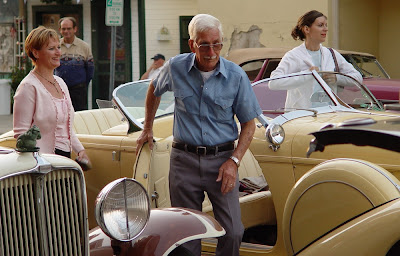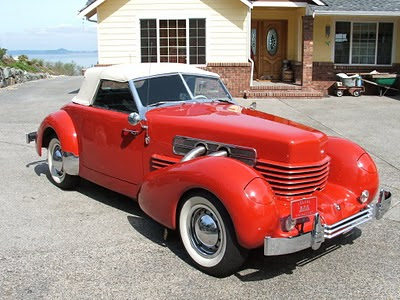 |
| Glenn Pray at a recent gathering of the cars he built and loved (Image courtesy David Turner) |
I lived in Norman, Oklahoma, from 1965 through 1972. I was into old cars. When I got my navy orders to go to Oklahoma to be a NROTC instructor, my 1932 Plymouth was my everyday car. So I did what any young, single, slightly crazy old car nut would do -- I drove my 33-year-old 4-cylinder Plymouth from New London, Connecticut to Norman, Oklahoma. I drove it another year as well before I retired it for a future restoration.
One of the legendary characters I got to know in Oklahoma through my interest in old cars was a gentleman named Glenn Pray, a resident of Broken Arrow, near Tulsa I learned today that he had passed away last Wednesday. The world has lost one of its most colorful characters. I'm humbled to have known him.
Glenn Pray built cars. That may not seem so unusual until you realize that he built modern versions of vintage cars in a former pickle factory. These cars sold for lots of money, and there was a long waiting period to get one -- they were quite exclusive. At the time I first met Mr. Pray, he was producing extremely high quality replicas of the 1936 Auburn boattail speedsters. They were magnificent.
 |
| The first generation Glenn Pray built Cord Model 8/10, powered by a front-mounted Corvair engine |
Previously, he had built a modestly downsized version of the Model 810 Cord convertible. It was 8/10 size so he called it the Model 8/10.
How he got into the car business reads like a fairy tale. As he related it to me, he was a school teacher with a wife and a couple of kids and he restored Cord automobiles and bought and sold them to supplement his teacher's salary. He often bought parts from Mr. Dallas Winslow, who had acquired the remnants of the Cord-Auburn-Duesenberg Company when it went into receivership in 1938. In the Spring of 1960, Glenn heard a rumor that someone was planning to buy the company from Mr. Winslow and he immediately became concerned. What might happen to his source of vintage parts?! He had hoped that maybe someday he himself might buy the inventory, but on his teacher's salary, he had never come up with the kind of money it would take.
He told me that he borrowed a few dollars from the teachers' petty cash fund and convinced a fellow teacher to go with him to Indiana to see about buying a car company. This friend had a 1956 Mark II Continental that had been badly wrecked on one side, but the other side looked pretty good. Glenn made an appointment to meet Mr. Winslow at a certain location, and he made sure to park the car with the "good side" toward the building. Mr. Winslow showed Glenn the remnants of the A-C-D Company -- hundreds of bins full of vintage parts. Glenn said that the universal joints needed to restore the front wheel drive of the Cords had become quite expensive and here he saw hundreds of them in a bin! After the tour, they discussed the price for a buyout (remember, Glenn doesn't have a pot to pee in) and agree on a price of $75,000!
 |
| The Cord production line in around 1963 |
Glenn and his friend dashed back to Tulsa to cover a check he wrote for a down payment. He convinced his teachers' credit union to give him a short-term loan. He had told Mr. Winslow that he needed a couple months to liquidate some assets to come up with the balance. Glenn told the bank that the owner had committed to financing half the deal. That somehow convinced the banker that this was an acceptable risk, so the bank loaned him nearly $40,000. He then went back to Dallas Winslow and asked him to to finance the balance. As Glenn related it to me, "Mr. Winslow figured if the bank would loan me that kind of money, I must be a pretty good risk!" Mr. Glenn Pray, school teacher and car enthusiast became the proud owner of the remaining assets of the Auburn Cord Duesenberg Automobile Company. This included tons of parts as well as documents and trademarks and copyrights. Over the next several months, Glenn moved everything to Broken Arrow. During this time, I recall that he also took on a financial partner, a Chevrolet dealer from Illinois named Wayne McKinley.
Within a few years of acquiring the company, Mr. Pray designed (with the help of Mr. Gordon Buehrig, the designer of the original Cord model 810) a smaller version of the 1936 Cord Model 810. It was about 8/10 scale, so Glenn named it the Cord 8/10. Over the next couple of years (1964-1966), the company built close to 100 of the cars, powered by Corvair air cooled flat 6 engines and front wheel drive. That business got acquired by another firm that produced a version of these cars for a few more years.
 |
| The Mark II hubcap |
I traded the propeller in an even trade for the five Mark II hubcaps, and I even talked Glenn into paying the shipping on both items! I was thrilled and I think he was happy. He told me in a later conversation that he had tracked down the history of the strange propeller. It was a spare propeller made for an experimental army bomber that crashed in testing at Fort Leonard Wood in Missouri. He had acquired the wreckage and was attempting a restoration. That sounded so typical of the Glenn Pray I knew. A lot of people will miss him.



3 comments:
Thanks for the blog on Glenn. Have you read his latest book called "Glenn Pray, The Untold Stories"? If not, I highly suggest that you get it. It has some behind the scenes stories that will make you laught and cry. Two movie producers are considering making it into a movie.
I appreciate this thoughtful and heartfelt account of my uncle's work and life! My beloved father, the late Walter L. Pray, was Glenn's older brother and served as his plant manager for years. An American success story!
Thanks to all who put up the articles on Glen Pray. My wife and I purchased a Auburn Model 866 Boattail speedster 2 weeks ago at the Branson Auto Auction. Same color as the one in the picture red and black. There was no documentation,and I have been spending hours on the computer trying to find out more information on the car. We need a few replacment parts and history. Please call 314-753-9444 if you could, or email budkurls@aol.com ask for Jim Konersman
Post a Comment